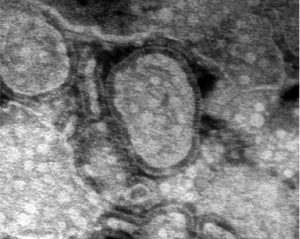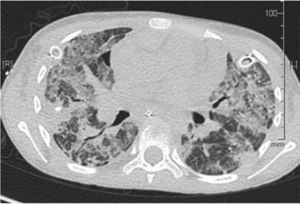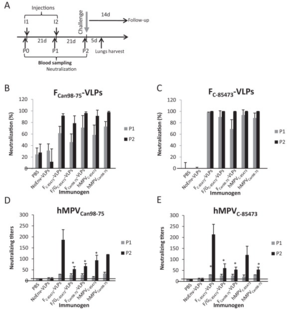Human Metapneumovirus
Introduction
Other examples:
Bold
Italic
Subscript: H2O
Superscript: Fe3+
Susceptible Groups
Interestingly, HMPV seems to target primarily children under the age of five (van den Hoogen et al, 2002). Specifically, symptoms are seen between the ages of six months and five years (Schildgen et al, 2011). Until later studies were performed, HMPV was only identified in children under the age of five. However, shortly after van den Hoogen et al (2002) performed their second study dealing with the virus, another group began to examine the symptoms and effects of the virus. This group determined that not only were young children at a higher risk for severe HMPV infection, so were elderly patients (Boivin et al, 2002). This then makes elderly patients the second group identified as a specific risk group for HMPV. Healthy adults are very rarely infected with HMPV, but it has been shown that the virus functions better in situations where the individual infected is immunocompromised (Boivin et al, 2002). The third group at risk, then, consists of individuals who have compromised immune systems, for one reason or another. Immunocompromised individuals can include those who have autoimmune diseases (such as HIV/AIDS), individuals who have cancer, or those who have suppressed immune systems for other reasons, such as people who are on immunosuppressants following an organ transplant.
Given the above information, the three major target groups for HMPV are young children, elderly individuals (over the age of 65), and those who are immunocompromised. The illnesses which result after infection occurs also vary based on age group. Children under the age of five tend to suffer more from pneumonitis and bronchiolitis, while patients over the age of sixty-five tend to suffer from bronchitis and pneumonitis (Boivin et al, 2002). The patients who have lowered immune function also suffer most commonly from pneumonitis (Boivin et al, 2002). Boivin et al (2002) also focused on more severe cases than did van den Hoogen et al (2002), providing valuable insight into the degrees of severity which can be related to HMPV infection. The virus also does not spread from the respiratory tract, but infects solely this area of the human system. In addition, HMPV has never spread in any of the model organisms which have been used for its study, indicating that something about the virus causes it to preferentially infect only the respiratory tract (Schildgen et al, 2011).
HMPV readily infects the above groups of people; however, it has a fairly low infection rate among healthy individuals, which means that it is rarely the primary cause of ailment among this group (Schildgen et al, 2011). In fact, healthy individuals usually only express HMPV symptoms when some other ailment has caused the immune system’s function to decline (Boivin et al, 2002). This, in turn, means that HMPV can be a cause of hospitalization, but usually only when the patient is already afflicted with some other illness. There is a chance of coinfection with HMPV and it can coinfect with several other viruses and infectious agents (Schildgen et al, 2011). HMPV can exacerbate an illness which is already present without being the primary cause of illness. In addition, in immunocompromised individuals, HMPV infections can be several times more severe than in healthy individuals, and can, in some cases, be fatal (Dokos et al, 2013).
Symptoms
Many of the symptoms exhibited by those infected with HMPV are similar to those seen in individuals infected by RSV, and can include everything from minor coughing to bronchitis and pneumonia, with degrees of severity ranging from relatively minor to lethal (van den Hoogen et al, 2002, Boivin et al, 2002). The high degree of similarity between the symptoms is one of the most prominent reasons why HMPV was not discovered until 2001 (Schildgen et al, 2011). Fortunately, tests have since been designed to screen for HMPV, which allows for differentiation between HMPV and RSV in clinical settings (Schildgen et al, 2011). The most common illnesses recorded in HMPV target groups were examined by Boivin et al in 2002, and they found that one of the most common resulting illnesses following HMPV infection is pneumonitis.
Perhaps one of the most interesting pieces of knowledge about HMPV is that, by the age of twenty-five, almost everyone has been exposed to the virus, and many have been infected with it. However, as stated previously, in healthy adults, the virus has little to no noticeable effect and doesn’t last long in the system (Schildgen et al¸ 2011, Boivin et al, 2002). Infections tend to begin to be noticeable at an age of around six months, but if no symptoms of HMPV infection have been observed by the age of five, it is unlikely that the individual will suffer from HMPV-related illnesses unless the individual becomes immunocompromised later in life (Schildgen et al, 2011). However, HMPV has been linked to some chronic respiratory conditions, particularly asthma (Schildgen et al¸2011). It has been demonstrated that individuals who are infected with HMPV early in life (before five years of age), have an increased risk of developing asthma later in life and may experience a more severe presentation of asthma than those who do not have HMPV-related asthma (Schildgen et al, 2011).
One case study examined the incidence of a ten-year-old girl who was admitted to the hospital after a stem cell transplant. The patient had cancer before the transplant and became infected with HMPV after, when her immune system was compromised as a result of the procedure (Dokos et al, 2013). Within a month of her admission to the hospital, the HMPV infection worsened enough to be lethal, as examined by Dokos et al (2013)¸ who took several scans of her lungs (see figure on right). Had this infection occurred in an individual with a healthy, functional immune system, it likely would have only presented as a minor cough, which shows how HMPV can take advantage of a compromised immune system to thrive in a host’s respiratory tract (Schildgen et al, 2011).
Vaccine Development
There has been some evidence that a vaccine for HMPV was created using virus-like particles (VLPs), rather than an attenuated form of the virus or an inactivated virus (Lèvy et al, 2013). According to this study, the VLPs are better for making a vaccine for this particular virus because, while the attenuated or inactivated vaccines can create an immune response in the test organism or patient, it does not have quite as good of a chance of lasting over a long-term time period (Lèvy et al, 2013). Because of this, the authors of this study chose to test the effects of VLPs, despite the fact that VLPs are harder to create for enveloped viruses (which all members of the paramyxovirus family are) (Lèvy et al, 2013). VLPs also have the advantage of being less dangerous to patients with suppressed or compromised immune systems because the VLP contains none of the genetic material of the virus, just a protein coat. This makes VLPs particularly applicable to the study of this virus, given that it primarily targets those who have immune systems which are not functioning properly (Schildgen et al¸2011, Lèvy et al, 2013). The purpose of the VLPs is to mimic the surface proteins found on the surface of the HMPV virion (Lèvy et al, 2013).
HMPV has three glycoproteins which can be found on the surface of the virion: a G protein, an F protein, and an SH protein (Schildgen et al, 2011). The G protein serves the function of helping the virion attach to a host cell. The G protein is the protein which differs the most between the lineages of HMPV (Schildgen et al, 2011). The F protein facilitates the fusion of the virion membrane with the host membrane, allowing the virus to deposit its genetic material inside of the host cell (Schildgen et al, 2011). After that, the virus' genetic material is transcribed into positive-sense RNA before more proteins are made. The majority of HMPV's mechanism of reproduction has not been studied. However, it is likely that the mechanism will be similar to that of other paramyxoviruses (Schildgen et al, 2011). The third surface protein is the SH protein, the function of which has yet to be discovered (Schildgen et al, 2011). There is a significant difference in the length of the SH protein in HMPV and RSV, however, indicating that both viruses are still functional, even with their different versions of the protein. Studies were performed in which the SH protein was removed from HMPV, but it did not affect the ability of the virus to propagate or act as a pathogen (Schildgen et al, 2011).
These three glycoproteins are mimicked on the surface of a VLP to trick the host immune system into developing a response to HMPV (Lèvy et al, 2013). The study was performed using a mouse model, where the mice were first injected with VLP for a prescribed amount of time (Lèvy et al, 2013). Blood samples were analyzed for antibody production, and at the end of the study, the mice were infected with HMPV (Lèvy et al, 2013). They were then compared to control mice (which had never been injected with VLPs) to see if there was an immune response difference (Lèvy et al, 2013). The mice which had been injected with VLPs were much more capable of resisting the HMPV infection (see figure at right). To see if the treatment would still work across different strains of HMPV, the group had two test groups, each injected with a VLP for a different strain of HMPV (Lèvy et al, 2013). These groups were then split into two again, and of each group, half was infected with the same strain as their VLP, while the other half was infected with the strain which was different from their VLP (Lèvy et al, 2013). In both cases, mice which had been exposed to VLPs fared significantly better against HMPV than mice which had not been treated with any VLPs (Lèvy et al, 2013).
References
4. Boivin, G., Abed, Y., Pelletier, G., Ruel, L., Moisan, D., Côté, S., Peret, T. C. T., Erdman, D. D., and Anderson, L. J. (2002) Virological features and clinical manifestations associated with human metapneumovirus: a new paramyxovirus responsible for acute respiratory-tract infections in all age groups., The Journal of infectious diseases 186, 1330–4.
5. van den Hoogen, B. G., Bestebroer, T. M., Osterhaus, A. D. M. E., and Fouchier, R. a M. (2002) Analysis of the genomic sequence of a human metapneumovirus., Virology 295, 119–32.
6. Dokos, C., Masjosthusmann, K., Rellensmann, G., Werner, C., Schuler-Lüttmann, S., Müller, K.-M., Schiborr, M., Ehlert, K., and Groll, a H. (2013) Fatal human metapneumovirus infection following allogeneic hematopoietic stem cell transplantation., Transplant infectious disease : an official journal of the Transplantation Society 1–5.
7. Bayon-Auboyer, M.-H., Arnauld, C., Toquin, D., and Eterradossi, N. (2000) Nucleotide sequences of the F, L and G protein genes of two non-A/non-B avian pneumoviruses (APV) reveal a novel APV subgroup, J. Gen. Virol. 81, 2723–2733.
8. de Graaf, M., Herfst, S., Schrauwen, E. J. A., Choi, Y., van den Hoogen, B. G., Osterhaus, A. D. M. E., and Fouchier, R. A. M. (2008) Specificity and functional interaction of the polymerase complex proteins of human and avian metapneumoviruses., The Journal of general virology 89, 975–83.
9. Crowe, J. E. (2004) Human Metapneumovirus as a Major Cause of Human Respiratory Tract Disease, The Pediatric Infectious Disease Journal 23, S215–S221.
10. Bach, N, C., and D,; Brouard, J,; Lafay, F,; Freymuth, F,; Legrand, L,; Guillois, B,; Duhamel, J. (2004) Acute respiratory tract infections due to a human metapneumovirus in children: descriptive study and comparison with respiratory syncytial virus infections, Archives de Pediatrie : Organe Officiel de la Societe Francaise de Pediatrie 11, 212–215.
11. Peret, T. C. T., Boivin, G., Li, Y., Couillard, M., Humphrey, C., Osterhaus, A. D. M. E., Erdman, D. D., and Anderson, L. J. (2002) Characterization of human metapneumoviruses isolated from patients in North America., The Journal of infectious diseases 185, 1660–3.
Edited by student of Joan Slonczewski for BIOL 238 Microbiology, 2013, Kenyon College.



